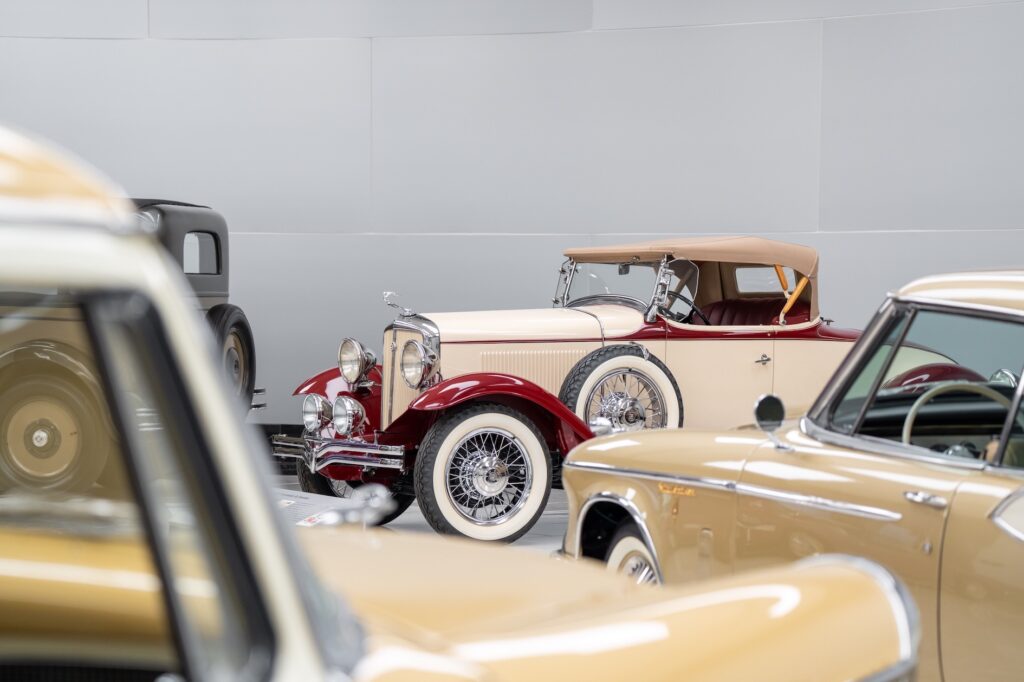Savoy Automobile Museum, Cartersville (Georgia), USA
until August 3, 2025
The Savoy Automobile Museum’s “Stunning Studebakers” exhibition highlights an American brand renowned for the quality of its cars. Despite numerous innovations throughout its history, the brand’s development was at times chaotic, due to major crises and world wars. Moreover, the emergence of the “Big Three” (Ford, GM and Chrysler) left little room for smaller, independent manufacturers.

Featuring a dozen models, mainly from the Savoy Museum’s permanent collection and the National Studebaker Museum’s collection, the exhibition highlights several of the brand’s emblematic automobiles, from the periods before and after WWII. With its 5.8L in-line 6-cylinder engine, the President represented the top of the Studebaker range in the 1920s, especially in the Limousine version on display. The chrome grille and double-bar bumpers were elements of styling sophistication.



The names Commander, President, Champion (and the more questionable Dictator) clearly indicated Studebaker’s “top-of-the-range” target. The early 1930s were a difficult period for American manufacturers after the 1929 Great Depression, particularly for luxury brands. Despite interesting models such as the rare Roadster Six and more economical models such as the “Rockne” range, Studebaker came close to bankruptcy but managed to turn its fortunes around.
The production of trucks and military equipment during the war certainly gave the brand a second wind. After the 2nd World War, Studebaker presents itself as “First by Far with a Postwar Car”. The new 1947 Champion and Commander were presented in a modern style by renowned designer Raymond Loewy, and Studebaker established itself as a style leader.
The 1950 Champion (shown here as a convertible) featured a grille with a central opening resembling a turbine intake. Original, but abandoned after 2 years because the public “didn’t take to it”. In 1956, the “Presidents” adopted a more consensual style. Curiously, Studebaker persisted with a large 2-door station wagon, while all competitors offered 4 doors. Although the styling appealed, production was very limited.






The Commander and Golden Hawk models stood out from classic American production thanks to their original, steeply raked front end. Introduced in 1963, the Lark sedan was a compact car (in the US standards) and was a great success at first. But the launch of compact models by Chrysler, Ford and GM compromised sales levels.




In 1962, Studebaker launched the Avanti, a sports car designed by Raymond Loewy, probably the car most often associated with the designer. The Avanti’s “underpinnings” are familiar and classic, with its “289” V8 (4.7L). The style, however, is highly original and unmistakable, with a grille with no opening surrounded by the extension of the front fenders. The bodywork innovates with the use of fiberglass. Unfortunately, budgetary constraints and short design times led to several problems, not least the hardening of the fiber. Delivery times lengthened and buyers moved away from the model (which benefited the Chevrolet Corvette).


But the design of the Avanti (the aptly named) was so avant-garde that it was taken up again after Studebaker production ceased in 1964 and produced until 2006 by a succession of different manufacturers with little or no change to the original design.
The photos on this page belong to the Savoy Automobile Museum, no right of reproduction without the express permission of the museum.
